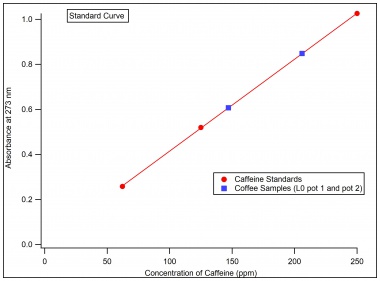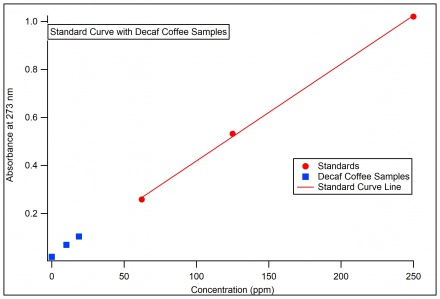Difference between revisions of "Caffeine Standards"
(Created page with "We made four different caffeine standards in concentrations of 500 ppm, 250 ppm, 125 ppm, and 62.25 ppm. The following is the procedure used to create these standards. ''Proc...") |
|||
| (43 intermediate revisions by the same user not shown) | |||
| Line 1: | Line 1: | ||
We made four different caffeine standards in concentrations of 500 ppm, 250 ppm, 125 ppm, and 62.25 ppm. The following is the procedure used to create these standards. | We made four different caffeine standards in concentrations of 500 ppm, 250 ppm, 125 ppm, and 62.25 ppm. The following is the procedure used to create these standards. | ||
| − | ''Procedure'' | + | '''Procedure''' |
Calculate the amount of caffeine needed to make the desired concentration of 500 ppm in 100 mL of water. We found this concentration to require 0.05 g of caffeine. Next, fill one 100 mL volumetric flask with 100 mL of water and three 100 mL volumetric flasks with 50 mL of water. Place a stir bar and the caffeine into the flask with 100 mL of water. Place this solution on a stir plate and allow to stir until the caffeine is fully dissolved, creating the 500 ppm solution. After the caffeine is fully dissolved, pour 50 mL of the 500 ppm solution into one of the other three flasks. This step creates the 250 ppm solution. Repeat this process by pouring 50 mL of the 250 ppm solution into one of the remaining two flasks with 50 mL of water to create the 125 ppm solution. Repeat this process one final time to create the 62.25 ppm solution by pouring 50 mL of the 125 ppm solution into the remaining flask. | Calculate the amount of caffeine needed to make the desired concentration of 500 ppm in 100 mL of water. We found this concentration to require 0.05 g of caffeine. Next, fill one 100 mL volumetric flask with 100 mL of water and three 100 mL volumetric flasks with 50 mL of water. Place a stir bar and the caffeine into the flask with 100 mL of water. Place this solution on a stir plate and allow to stir until the caffeine is fully dissolved, creating the 500 ppm solution. After the caffeine is fully dissolved, pour 50 mL of the 500 ppm solution into one of the other three flasks. This step creates the 250 ppm solution. Repeat this process by pouring 50 mL of the 250 ppm solution into one of the remaining two flasks with 50 mL of water to create the 125 ppm solution. Repeat this process one final time to create the 62.25 ppm solution by pouring 50 mL of the 125 ppm solution into the remaining flask. | ||
| + | |||
| + | |||
| + | {| | ||
| + | |[[File:caf_std_500.jpg|390px|thumb|center|Figure 1. Graph of the caffeine standards including 500 ppm]] | ||
| + | |[[File:StandardCurve060619.jpg|380px|thumb|center|Figure 2. Graph of the caffeine standards and two coffee samples of L0 coffee]] | ||
| + | |[[File:DecafStandardCurve.jpg|440px|thumb|center|Figure 3. Graph of the caffeine standards and two decaf coffee samples]] | ||
| + | |||
| + | |} | ||
| + | |||
| + | |||
| + | |||
| + | |||
| + | As figure 1 shows, the 500 ppm standard ended up making our standard curve nonlinear, so we decided to remove this standard from our data sets for the rest of the trials. | ||
| + | As figure 2 shows, our final set of standards created a linear standard curve. Our coffee samples were diluted 50% so they would fall between our caffeine standards. | ||
| + | As figure 3 shows, the decaf coffee had such low concentrations of caffeine that they did not fall between our sets of standards. | ||
Latest revision as of 14:36, 3 July 2019
We made four different caffeine standards in concentrations of 500 ppm, 250 ppm, 125 ppm, and 62.25 ppm. The following is the procedure used to create these standards.
Procedure
Calculate the amount of caffeine needed to make the desired concentration of 500 ppm in 100 mL of water. We found this concentration to require 0.05 g of caffeine. Next, fill one 100 mL volumetric flask with 100 mL of water and three 100 mL volumetric flasks with 50 mL of water. Place a stir bar and the caffeine into the flask with 100 mL of water. Place this solution on a stir plate and allow to stir until the caffeine is fully dissolved, creating the 500 ppm solution. After the caffeine is fully dissolved, pour 50 mL of the 500 ppm solution into one of the other three flasks. This step creates the 250 ppm solution. Repeat this process by pouring 50 mL of the 250 ppm solution into one of the remaining two flasks with 50 mL of water to create the 125 ppm solution. Repeat this process one final time to create the 62.25 ppm solution by pouring 50 mL of the 125 ppm solution into the remaining flask.
As figure 1 shows, the 500 ppm standard ended up making our standard curve nonlinear, so we decided to remove this standard from our data sets for the rest of the trials.
As figure 2 shows, our final set of standards created a linear standard curve. Our coffee samples were diluted 50% so they would fall between our caffeine standards.
As figure 3 shows, the decaf coffee had such low concentrations of caffeine that they did not fall between our sets of standards.


